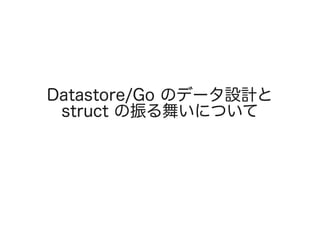Datastore/Go のデータ設計と struct の振る舞いについて
- 2. 自己紹介 twitter : pospome blog :pospomeのプログラミング日記 職種 : サーバサイドエンジニア 興味 : クラス設計全般, DDD アイコン:羊じゃなくてポメラニアン その他 :「ポメ」って呼んでください。
- 4. ソーシャルゲームのユーザー情報を表現する User Kind を 例に説明します
- 5. ID TEL Email Profile Image Profile Movie HP ATK DEF 1 000 x x.png 100 100 100 2 111 y y.mp4 50 50 50 3 222 z z.png 200 200 200
- 6. RDBで考えるとこの構造で問題ないかもしれないが Datastore で適切とは限らない Datastore のデータ構造をマッピングした struct の 振る舞いを通して考えてみる
- 7. 例1 ProfileImage と ProfileMovie は どちらか一方しか登録できない という仕様を表現する
- 8. ID TEL Email Profile Image Profile Movie HP ATK DEF 1 000 x x.png 100 100 100 2 111 y y.mp4 50 50 50 3 222 z z.png 200 200 200
- 9. type User struct { //他のフィールドは省略 ProfileImage, ProfileMovie string } それぞれが単なるフィールドだと 「Image, Movie どちらか一方を登録する」 という仕様を表現するのは難しい
- 10. これを修正すると???
- 11. type User struct { Profile Profile } type Profile struct { Image, Movie string } func NewImageProfile(image string) Profile { return Profile{ Image: image, } } func NewMovieProfile(movie string) Profile { return Profile{ Movie: movie, } } 「Image, Movie どちらか一方を登録する」 というルールを Profile 自体に持たせることで 仕様を表現することができる
- 12. ID TEL Email Profile. Image Profile. Movie HP ATK DEF 1 000 x x.png 100 100 100 2 111 y y.mp4 50 50 50 3 222 z z.png 200 200 200
- 13. 例2 Email, TEL は OAuth Scope = Contact でしか取得できない という仕様を表現する
- 14. ID TEL Email Profile. Image Profile. Movie HP ATK DEF 1 000 x x.png 100 100 100 2 111 y y.mp4 50 50 50 3 222 z z.png 200 200 200
- 15. type User struct { TEL, Email string } func Get(scope string) User { var u User = GetUserFromDB() if scope != "Contact" { u.TEL = "" u.Email = "" } return u } ロジック上で Contact scope = Email, TEL を表現している
- 16. これを修正すると???
- 17. type User struct { Contact Contact } type Contact struct { TEL, Email string } func Get(scope string) User { var u User = GetUserFromDB() if scope != "Contact" { u.Contact = nil } return u } Scope が扱う Contact という概念は 具体的に TEL, Email を含む 抽象度の違う値同士を扱おうとすると、 ロジックが複雑になる可能性がある TEL, Email という具体的な概念を Scope の Contact という抽象度に合わせる Scope と struct が一致しているので、 直感的に理解しやすい Contact の持つ値が変化しても、 u.Contact = nil に修正は発生しない これはロジックが Contact という抽象度の概念 を扱っているからであって、 t.TEL = “” のように抽象度がマッチしない場合 に比べると変更に強くなる
- 18. ID Contact .TEL Contact .Email Profile. Image Profile. Movie HP ATK DEF 1 000 x x.png 100 100 100 2 111 y y.mp4 50 50 50 3 222 z z.png 200 200 200
- 19. 例3 ATK, DEF は HP の値によって増減する という仕様を表現する
- 20. ID Contact .TEL Contact .Email Profile. Image Profile. Movie HP ATK DEF 1 000 x x.png 100 100 100 2 111 y y.mp4 50 50 50 3 222 z z.png 200 200 200
- 21. type User struct { HP, ATK, DEF int } func (u *User) GetAtk() int { //HPに依存する return u.ATK * u.HP } func (u *User) GetDef() int { if u.HP < 100 { //ピンチになると強くなる return u.DEF * 2 } return u.DEF } それぞれの値を算出するロジックは HP, ATK, DEF に依存しているが、 他の値には依存していない
- 22. これを修正すると???
- 23. type User struct { Battle Battle } type Battle struct { HP, ATK, DEF int } func (b *Battle) GetAtk() int { //HPに依存する return b.ATK * b.HP } func (b *Battle) GetDef() int { if b.HP < 100 { //ピンチになると強くなる return b.DEF * 2 } return b.DEF } HP, ATK, DEF を Battle として定義 「対戦」に関するロジックは Battle に集中させる User は「対戦」以外のロジックに集中できる 対戦のロジックはゲームのコアな要素なので、 複雑な仕様になりやすい User から分離しておくと Battle に interface を持たせて 特定のロジックを抽象化させたり、 固定値を設定した Battle に差し替えるなど、 User を汚さずに「対戦」を表現できる
- 24. ID Contact .TEL Contact .Email Profile. Image Profile. Movie Battle. HP Battle.A TK Battle. DEF 1 000 x x.png 100 100 100 2 111 y y.mp4 50 50 50 3 222 z z.png 200 200 200
- 25. ということで、最终的に???
- 26. type User struct { ID int64 Contact Contact Profile Profile Battle Battle } type Contact struct { TEL, Email string } type Profile struct { Image, Movie string } type Battle struct { HP, ATK, DEF int } 振る舞いを考慮すると User struct は以下になる
- 27. ID Contact .TEL Contact .Email Profile. Image Profile. Movie Battle. HP Battle.A TK Battle. DEF 1 000 x x.png 100 100 100 2 111 y y.mp4 50 50 50 3 222 z z.png 200 200 200 User struct を保存する User Kind は以下になるので、 最初のデータ構造とは違うものになった
- 28. まとめ
- 30. RDBだと struct の構造を そのまま保存するものではないので 必要に応じてORMや手動マッピングロジックで 永続化データとモデルをマッピングする struct の振る舞いを考慮してテーブル構造を 考える必要性は低い 永続化データとしての正しさを考えればいい RDBはSQLによる柔軟なクエリが可能なので、 無理やり struct を保存する工夫をするよりも 永続化データとしての正しさを重視した方がいい
- 31. Datastore は struct をそのまま保存できるので、 データ設計の段階で struct を考慮して設計すると 手戻りが少なく、 自分でインピーダンスミスマッチを解消する必要もない 極端に言うと Datastore設計 = モデル設計 ただし、 Datastore に保存できないデータ構造もあるので注意
- 32. Kind のプロパティ名に Prefix がある場合は その値は関連性の高い値である可能性が高い 関連性の高い値は それ独自の振る舞いや特性を持つ可能性が高い そういった関連性の高いデータに対して 仕様を表現するロジックを紐付けることによって、 責務が明確になる
- 35. おわり



































